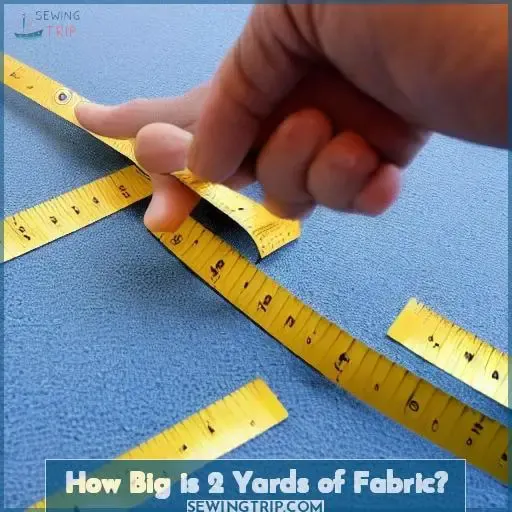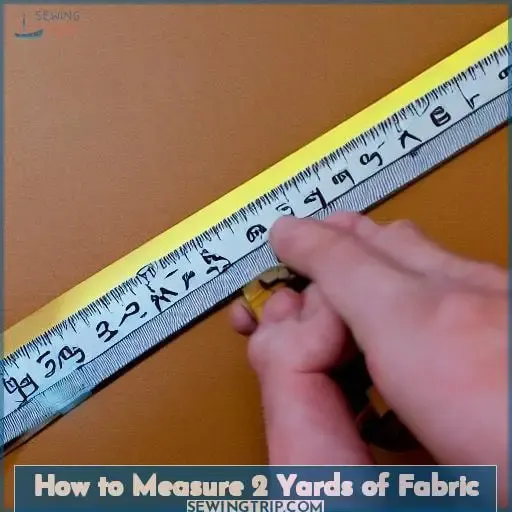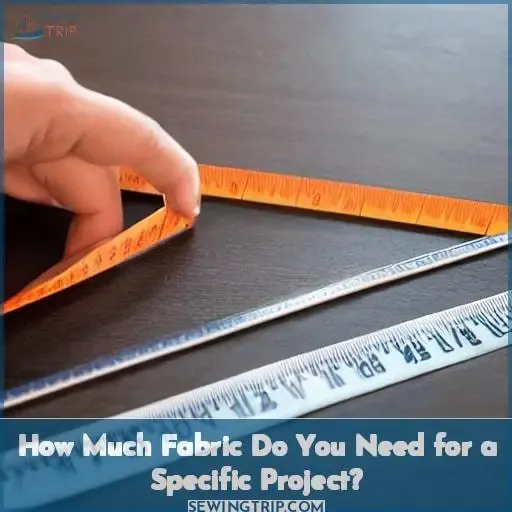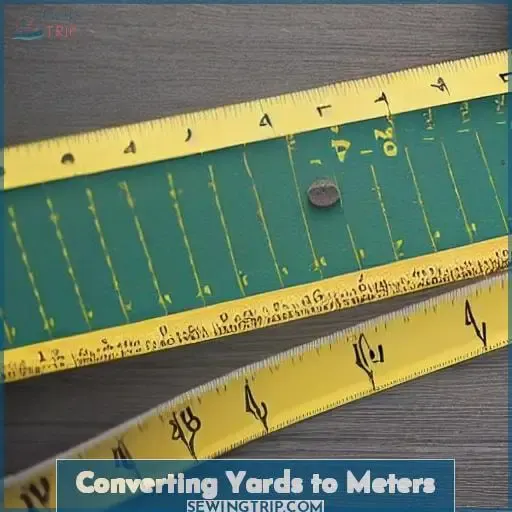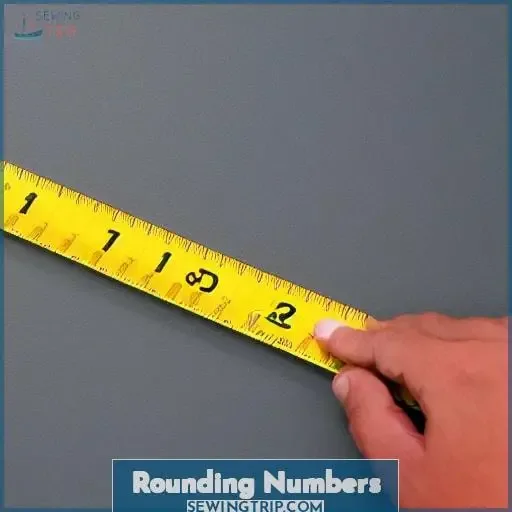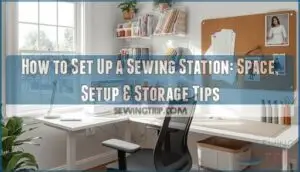This site is supported by our readers. We may earn a commission, at no cost to you, if you purchase through links.
You may have heard two yards and wondered how much fabric it is. One yard is equal to 36 inches or 3 feet. So two yards is double that – 72 inches or 6 feet. It’s hard to visualize something so abstract without seeing it. Let us take you on a journey and help make your next project easier!
Table Of Contents
Understanding Fabric Measurements
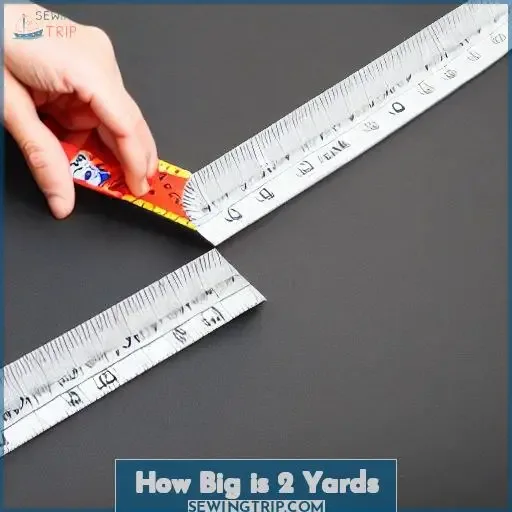
Are you looking to understand fabric measurements? A yard is a linear unit that measures 36 inches, 3 feet, or 0.9144 meters. The width can vary from 43-60 inches.
Knowing how much material you need for your project is crucial. Understanding what two yards looks like in those different measurements will help make sure you have enough!
Yard of Fabric
You can easily measure out two yards of fabric with just one glance – it’s the perfect length for a variety of projects! Knowing how big 2 yards is essential when selecting fabric and helps to ensure you have enough material.
A yard of fabric is 36 inches, 3 feet, 0.9144 meters or 91.44cm in length and usually ranges from 43-60 inches wide, depending on the type of weave used in its construction, as well as its pattern and color.
To accurately measure out two yards (72 inches), use a tape measure starting at the selvage edges – this will give you an exact measurement for your project needs!
From cotton weaves to linen fabrics, understanding how much material two yards equates to is key knowledge that all sewers should possess:
- Fabric Weaves
- Fabric Types
- Fabric Care
- Fabric Patterns
- Fabric Colors
Linear Yard
By understanding the linear yard, you can easily determine how much fabric is needed for any project – no more guessing or overestimating!
A linear yard of fabric is 36 inches, 3 feet, 0.9144 meters or 91.44cm long and the widths often vary from 43 to 60 inches.
Knowing your piece of fabric’s length in yards also allows you to convert it into various metrics such as cm and m so that your measurements are always accurate when working with different fabrics like cotton or linen with varying thread count and weight.
With this knowledge at hand, estimating yardage becomes easier than ever before!
Fabric Width
You can easily determine the width of your fabric by knowing its length in yards – just remember that fabric stores only measure and cut the length, not the width! To figure out how wide a yard (or multiple yards) of any given fabric is, look at either bolt widths or patterns. Bolt widths are generally 43-60 inches, and most fabrics come in 1-yard cuts. For something more specific, there are online resources like a fabric measurements calculator. It’ll help with yardage calculations and other related topics like weaving or yard weights.
How Big is 2 Yards of Fabric?
You may be wondering how big 2 yards of fabric is. Well, it’s 72 inches or 6 feet in length. Width can vary from 43–60 inches, depending on the material. For a better visual, check out online photos comparing different lengths and widths to a 5ft 8in person and other yard measurements. This’ll give you an idea of what two yards looks like.
2 Yards of Fabric Length
You may not have realized it, but 2 yards of fabric is equal to 72 inches, 6 feet, 1.8288 meters, and 182.88cm – quite an impressive length! It’s important to consider the weave and weight when choosing a fabric for your project, as well as the kind of cut – fat quarter or shoulder widths. Make sure to pay attention to color too before heading off to the fabric store, so all pieces match perfectly.
Rounding can be used with decimal places when converting measurements. If it’s over 5, round up; otherwise, round down, so you don’t end up short on material.
2 Yards of Fabric Width
No matter what project you’re working on, the width of your 2 yards of fabric is essential; make sure to double-check it’s just right for your needs. A yard is a linear measurement which equals 36 inches or 3 feet. Fabric weaves and types can vary greatly in their measurements, so proper yardage estimation should be done before starting any sewing techniques.
To find out how wide two yards are, measure from the left hand side with a measuring tape and add up four times 18 inches (or one quarter yard) together until you reach 72 inches (or 2 yards). This will give you an accurate estimate as to the width of your fabric, allowing for proper care when cutting or storing it away afterwards.
Photo Comparisons
Get an idea of just how massive two yards of fabric is by viewing our photo comparisons! Our photos show a 5ft 8in person in comparison to 2 yards of fabric.
You can see that the length and width take up quite a bit more space than you’d expect. The widths often range from 43 inches up to 60 inches, while the length will always be 36 inches or 3 feet – no matter what type you purchase.
This makes it easier for those converting square yards into square feet or even meters. The exact weight and quality may vary, but it’s important to keep this info in mind when purchasing needles, thread colours or calculating yardage for any project involving sewing.
Now you have everything needed for finding out exactly how big two yards really are!
How to Measure 2 Yards of Fabric
Measuring two yards of fabric doesn’t have to be complicated. Lay it out flat. Use a ruler to mark off 72 inches from one side, or step forward with your feet until you reach the 2 yard mark.
Alternatively, use a measuring tape. Unroll it along the length of your fabric starting at one end until you reach 72 inches (6 feet).
These are straightforward ways for accurately determining how big two yards of fabric really is!
Method 1: on the Floor
See how much fabric two yards covers by laying it out on the floor – you’ll be amazed!
Use blue tac to measure out 2 yard lengths of fabric. You’ll see it’s approximately 6 feet long. Take fabric quality and width into account for an accurate result.
When cutting tips are needed, thread types, seam finishes and sewing machines come in handy to create your project with precision accuracy.
Exact measurements like two yards make it easy!
Method 2: Using a Tape Measure
Use a tape measure to measure two yards of fabric accurately. A yard is 36 inches, 3 feet, 0.9144 meters, or 91.44 cm long. The width varies from 43 inches to 60 inches, depending on the type and weight of fabric. Use a tape with helpful charts and conversion factors. Hold one end at the beginning point and extend the other until it reaches 2 yards, plus any extra for seam allowances if applicable. Mark off with right arrows and inch/cm markers. Most tapes measure include metric measurements, making them useful for different fabric weights and types.
How Much Fabric Do You Need for a Specific Project?
When deciding how much fabric you need for a specific project, it’s important to read the sewing pattern carefully. Measure your body or other object accurately. Consider what type of project you’re doing and if there’s extra needed for fitting. It can be daunting at first, but remember: with some careful thought and planning ahead of time, you’ll have enough fabric to complete your projects successfully!
1 Read the Sewing Pattern
Read the sewing pattern thoroughly and take time to understand it. This will help you tailor your fabric accordingly.
Familiarize yourself with basic fabric measurements such as fabric weight, conversion factors, fabric type, measuring tape and yard stick. This will allow you to measure a yard for any given project.
A yard of fabric describes its length only, not width. Width can vary from 43 inches up to 60 inches.
When converting yards into different metrics (e.g. meters or centimeters), round the decimal places up if above 5 and down if below 5. Otherwise you may find yourself short on material when starting your sewing project.
Keep an eye out for square yards. These correspond differently than regular linear yards: 1 square yard = 9 feet/1296 inch/0.836m2.
2 Measure Your Body
To get the fabric you need for your project, measure your body accurately. Consider factors like pattern matching, selvage edge measurements, and different fabrics weaves when determining yardage estimation. Utilize a full tutorial or a metric system of measurement for an easier conversion experience. Understand different measurement units such as inches or centimeters with accuracy using a Fabric Conversion Calculator tool online if needed!
Contractions can make a big difference.
3 Consider the Project
Consider the project you’re working on carefully and visualize how each length of fabric will appear – this should help you determine exactly how much material you need.
When choosing fabric, it’s important to estimate the yardage needed. Consider what type of fabric works best for your needs, such as wider or narrower fabrics. Follow instructions regarding cutting and caring for that type of fabric – it varies from store to store.
Right-hand rules are usually helpful when deciding which way is up on a bolt of wide widths at most stores. Taking these factors into account before purchasing 2 yards (or more) of material can make your finished product look great!
4 Add Extra
Want to make sure you have enough fabric for a project? Add an extra quarter- or half-yard of fabric to be safe! This is especially important if your pattern requires dense fabric weaves, yardage estimations, or length conversions.
Additionally, when pattern drafting and sewing patterns that involve larger pieces of material like the size of a folder or width of the standard sandwich board it’s recommended to purchase more than necessary so you don’t run short.
It’s also beneficial if there are variety in different rolling pins used as they come in multiple sizes which can affect how much material is required.
When measuring always remember that 1 yard equals 3 feet and use conversion charts when needed for accurate results!
Converting Yards to Meters
To quickly convert yards into meters, simply multiply the number by 1.094 – just remember to round up or down depending on the decimal! Converting fabric measurements from one unit of measurement to another can be tricky, but understanding how each unit works is key. Fabric density, thread counts and fabric weights are all important factors when selecting a specific type of material. With these tools, it’s easy to find out how much yardage is needed for any given project.
A sq yd (square yard) is a unit of area equal to 9 square feet, which equates 3 feet by 3 feet. One sq ft conversion equals 144 square inches. Knowing this information will help determine the amount of yardage needed for a particular pattern. It may also be helpful to look at online charts detailing different types of fabrics as well as their associated sewing tools, such as needles size and thread weight, that should be used with them.
With all this knowledge about converting yards into meters, anyone can confidently measure fabric accurately without fear of running short on supplies during their projects!
Rounding Numbers
Rounding is an important aspect of fabric measurements, so make sure you round your results to the nearest decimal place for accuracy!
There are several weighting options that can be used when estimating sizes depending on the situation. For example, when learning fractions and converting units from yards to meters it’s best practice to round up if the number’s above 5 or down if below 5.
Understanding these simple concepts will help you get accurate measurements with fabric today.
When choosing a selection at a store, rounding numbers helps ensure there won’t be any surprises after you purchase your roll of fabric and head home – saving yourself money in reusable bags as well!
Frequently Asked Questions (FAQs)
How much fabric is needed for a quilt?
Quilting is an art form that requires precision and thoughtfulness. With the right fabric sourcing, quilting patterns, yardage calculations and a handy chart for determining how much floor space you need to cover when buying from a fabric seller, plus taking into account thread counts and shrinkage risk of fabrics used, you can make sure your project comes out looking its best.
To make things easy, use letter paper as a guide: one yard of fabric will cover 3 feet or 36 inches, so with two yards you’ll be able to comfortably complete most projects without running short on material!
What is the best way to store fabric?
Storing fabric is a skill all sewing enthusiasts should master. Invest in quality storage containers for sorting and organizing different types of fabrics. Save space by using rolling pins to store large bolts of fabric instead of sandwich boards or letter-size school folders. For extra protection, seal delicate fabrics with resealable bags, or use Sunbeam heating pads to prevent wrinkles from forming.
With these tips, you’ll confidently store your fabric without any issues.
How do I estimate the amount of fabric for a sewing project?
Estimating the amount of fabric for a sewing project can be tricky. The type of fabric, quality, and size all need to be taken into consideration. It’s important to calculate yardage accurately so you have enough material.
Factors such as cream fabric on opposite sides or the size of a sandwich board will vary with each job. These should factor in when calculating yardage estimates.
To simplify this process, consider using techniques like measuring out sunbeam heating pad lengths. This can give an idea how much material is needed for each section. It can also be used as a general marketing tool to show customers what kind of projects they could do with different amounts and types of fabrics available at their local store!
What types of fabrics are best for curtains?
When it comes to choosing fabric for curtains, there are a few things to consider. Cost is important, so take into account the window measurements and curtain rods. You also need to select a fabric type that’ll work with your mobile device or standard heating pad if necessary.
Cotton fabrics may not be suitable as they come in an assortment of sizes; whereas polyester is often marketed for its durability and ability to fit any size from a license plate up!
Ultimately, selecting the right material can make all the difference when crafting custom made curtains, so take your time and find one perfect for your project!
What is the difference between a yard and a meter?
Do you ever wonder what the difference is between a yard and a meter? A yard is 36 inches, 3 feet, 9144 meters, or 44cm long u2013 but widths vary from 43 to 60 inches wide. Calculating fabric for sewing projects can be tricky, since there are different types of fabrics with varying properties; it’s important to estimate your yardage carefully! For comparison: one yard could fit on two sandwich boards or cover half the size of a billboard; two yards would fill up an entire yoga mat or fit in an average quart-size bag (like those used for school lunches); four yards might just about cover the length needed for car license plates!
Conclusion
Finally, understanding fabric measurements and how to accurately measure and convert yards of fabric can help you make sure you have enough for a project. Whether you’re making clothes for yourself or a quilt for a loved one, use the tips in this article to ensure you have the right amount. Measure your fabric, account for the project size, and round up. And if you’re ever feeling overwhelmed, just remember: it’s just fabric – you can always buy more!

